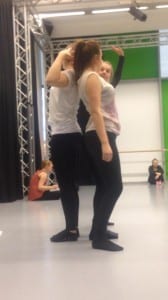‘Is it possible to do lifts with the same intention and fluidity in trios that it is in duets?’
This is the question my group proposed for our research lab. We decided to go with this question because whilst in a jam we don’t feel comfortable in lifting as a trio as
“Contact Improvisation is a duet movement form.” (Contact Quarterly’s Contact Improvisation Sourcebook, 1997, 16)
and because of this it is difficult to turn duet lifts into trio lifts.
For our research lab we started by trying out each lift that we had done as a duet and trying to make them into a three. We experimented with the back to back/see saw style lift, supporting the shoulder blades lift and the hip to hip lift with variation to hip to shoulder.
With the back to back lift we really struggled to start with as we had two under dancers and one over dancer and found that the over dancer struggled to get their pelvis over both of the under dancers and also the under dancers struggled to keep their pelvis’ at the same height. Here you can see the dancer preparing themselves for the lift however the lift didn’t work therefore there isn’t an image of the lift in action.
Because the lift didn’t work we then tried it the same way as we originally learnt it but with somebody under the original under dancer and found that this worked a lot better however the new under dancer has to be strong enough to take the weight of two people.
After this we went on to explore the supported shoulder blades lift with somebody extra supporting the legs, this felt like a completely different lift and worked really well but again only with certain people supporting certain areas.
Three of the members in my group then went on to do a mini jam and we found that the third person in the group would just be supporting the legs and this hindered where the movement would go.
After this research lab I still think that it contact improvisation is a duet and cannot be changed into a duet. More questions that came up from this jam are:
- Is there a way to change the person being lifted into the lifter smoothly in a trio?
- How can you pass the lift on without using arms/hands?
- How can you explore lifts in a trio without supporting the legs?
- How can trio lifts start from the floor and move upwards and/or travel and vice versa?
Contact Quarterly’s Contact Improvisation Sourcebook. (1997) Massachusetts: Contact Editions.


